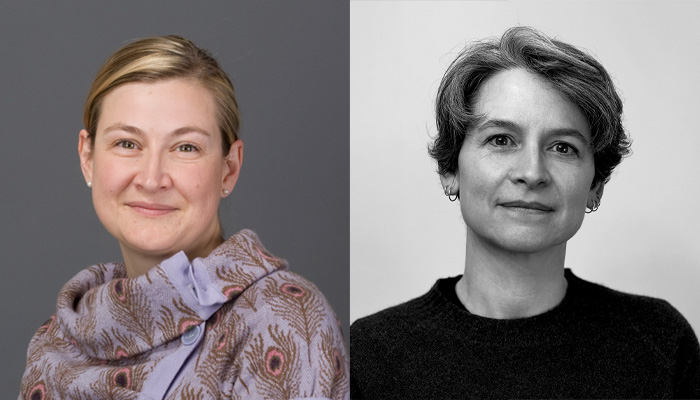
The Graphic and Digital Design (GDD) department recently hosted the inaugural events for its public seminar series, Counterforms: Practices, Theories, and Methods. Counterforms, moderated by assistant professor Trevor Embury, is hosted on the Abbotsford campus. The first two speakers were Dr. Katherine Gillieson (September 25th) and Dr. Bonne Zabolotney (October 9th) of Emily Carr University.
Dr. Katherine Gillieson is an associate professor of communication design, and associate dean of Emily Carr’s master of design program. Gillieson co-runs the Occasional Press, an on-campus publishing project that aims to utilize innovative, resilient modes of production and distribution, and The Stationary Project, which repurposes waste materials to create stationary products. She was also a lead designer on the Community Network Roadmap, an open-source tool for communities to establish and maintain broadband network solutions.
Dr. Bonne Zabolotney is an associate professor in the communication design program, master of design program, and the critical and cultural studies department. Zabolotney is the editor of the book Designing Knowledge: Emerging Perspectives in Design Studies Practices and was a collaborator on Co-designing with Anti-oppressive Action Frameworks for Curriculum and Pedagogy. The BCcampus Decolonization Grant Program funded this work in 2021-2022.
The changemaking principle of reciprocity encourages developing respectful relationships, engaging in active listening, and acting collaboratively when addressing complex social issues. Counterforms reflects this principle in the aim to have participants “[examine] design as a catalyst for community building, pushing boundaries, and driving social change” while “understanding design as an act of reconfiguration—shaping experiences, interactions, and meaning.”

Counterforms organizer and moderator Trevor Embury shared the following insights into the series.
How did the idea for Counterforms come about?
The idea for the Counterforms seminar series originated from a chapter titled “Lightness” in Ezio Manzini’s book Politics of the Everyday. In this chapter, Manzini explores the concept of meaningful encounters and the ecosystems that enable them, posing questions about how communities of place are built and how intentional actions create purposeful, open communities. This resonates deeply with me during a time when the world feels increasingly isolated and polarized. The metaphor of counterform, typically associated with negative space in design, was extended to represent new ways of thinking and challenging conventional norms. Inspired by these ideas, the seminar series was conceived as a platform to explore the gaps, contradictions, and oppositional ideas that provoke innovative perspectives and intellectual growth in design.
What stood out to you about the first two guest speakers?
Dr. Katherine Gillieson and Dr. Bonne Zabolotney, both from Emily Carr University, stood out for their ability to challenge conventional notions and reveal the often hidden, complex dimensions of design. Their perspectives go beyond traditional approaches, highlighting design’s capacity to act as a catalyst for community building and social change. Each speaker brings a unique lens to understanding design not only as a disciplined practice but also as an evolving field of inquiry that shapes experiences, interactions, and meaning in profound ways.
Do you plan to host more events in future semesters? If so, how would you like to see this series evolve and grow?
Yes, I plan to host more events in future semesters. Moving forward, I envision the series expanding in scope to include a broader range of perspectives, disciplines, and global contexts. I would like to see it grow into an interdisciplinary forum where design intersects with other fields such as environmental studies, social justice, and technology, pushing the boundaries of how design can be understood to address urgent societal issues. The series will continue to focus on exploring counterforms — both metaphorically and literally — as a way to rethink established norms and challenge current paradigms.
How do you see design as a means for social innovation?
Design has the potential to be a powerful tool for social innovation because it encourages creative problem-identifying, critical thinking, and engagement with the needs and desires of communities. By examining and reconfiguring systems, practices, and spaces, design can foster more inclusive, equitable, and sustainable futures. Through intentional design practices, we can create environments that support meaningful encounters, empower marginalized voices, and promote collaboration, ultimately driving positive social change.
Do you have any advice for students on how to bring the practice of changemaking into their design work?
My advice to students is to approach design as more than just aesthetics or functionality; it’s about understanding the broader social, cultural, and environmental contexts in which they work. To be effective changemakers, students should embrace a mindset of curiosity, openness, and intentionality. Engage with the gaps, contradictions, and challenges in your surroundings, and see these as opportunities for change and innovation. Collaborate with others, listen to diverse perspectives, and question how design can contribute to the well-being of both human and non-human worlds, including the planet.

